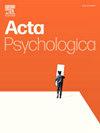Visual statistical learning initiates in/out-group judgments
IF 2.7
4区 心理学
Q2 PSYCHOLOGY, EXPERIMENTAL
引用次数: 0
Abstract
Our research examines how spatial proximity, shaped by visual statistical learning (VSL), initiates the categorization of individuals into in−/out-groups. We hypothesized that individuals positioned continuously closer in a visual array would be more frequently chosen as part of the in-group, while those farther away would be categorized as out-group members. In Experiment 1, participants selected individuals spatially associated as in-group members, while those associated differently and farther away were more often assigned to the out-group. Experiment 2 replicated these findings and refined the methodology by incorporating two types of visual representation: facial images and initials. These findings enhance our understanding of how VSL not only shapes perceptions of spatial proximity but also initiates the process of group judgments. Specifically, participants indirectly learned and recognized spatial regularities, which influenced their in-group and out-group decisions, underscoring the critical role of VSL in driving early-stage social categorization within virtual environments.
视觉统计学习启动群体内/群体外判断
我们的研究考察了由视觉统计学习(VSL)塑造的空间接近性如何开始将个体分类为内/外群体。我们假设,在视觉阵列中不断靠近的个体将更频繁地被选为内群体的一部分,而那些远离的个体将被归类为外群体成员。在实验1中,被试选择空间关联的个体作为群体内成员,而那些空间关联不同且距离较远的个体则更多地被分配给外群体。实验2重复了这些发现,并通过纳入两种视觉表征:面部图像和首字母来改进方法。这些发现增强了我们对VSL如何不仅塑造空间接近的感知,而且还启动了群体判断过程的理解。具体而言,参与者间接学习和识别空间规则,这影响了他们的群体内和群体外决策,强调了虚拟语言在推动虚拟环境中早期社会分类中的关键作用。
本文章由计算机程序翻译,如有差异,请以英文原文为准。
求助全文
约1分钟内获得全文
求助全文
来源期刊

Acta Psychologica
PSYCHOLOGY, EXPERIMENTAL-
CiteScore
3.00
自引率
5.60%
发文量
274
审稿时长
36 weeks
期刊介绍:
Acta Psychologica publishes original articles and extended reviews on selected books in any area of experimental psychology. The focus of the Journal is on empirical studies and evaluative review articles that increase the theoretical understanding of human capabilities.
 求助内容:
求助内容: 应助结果提醒方式:
应助结果提醒方式:


